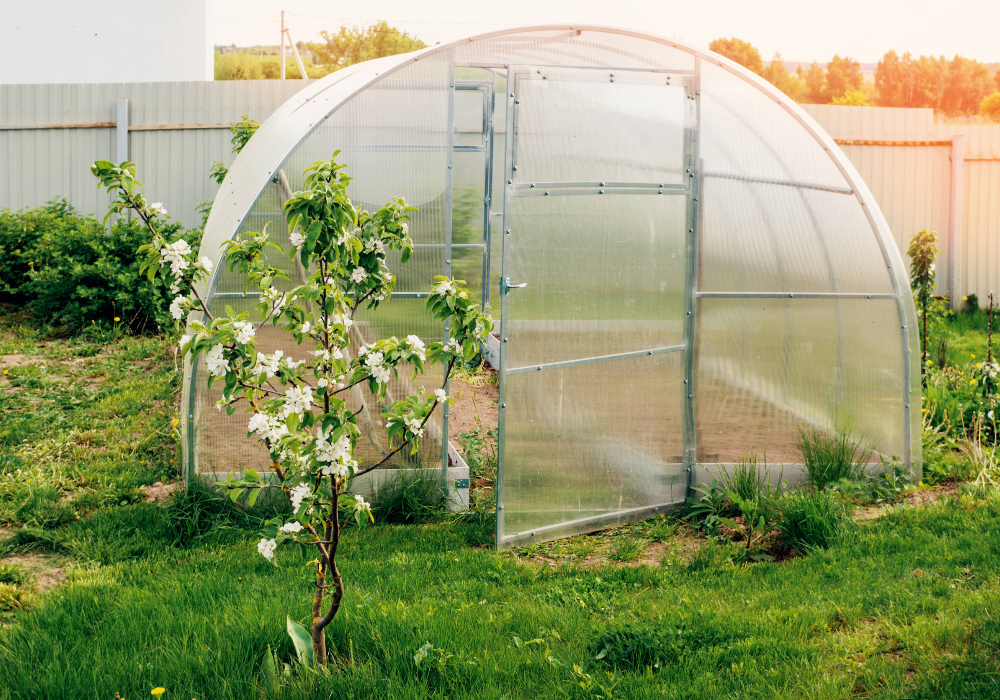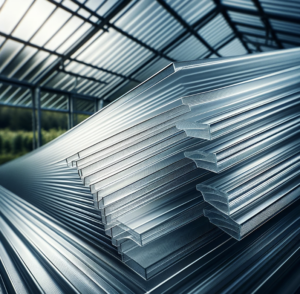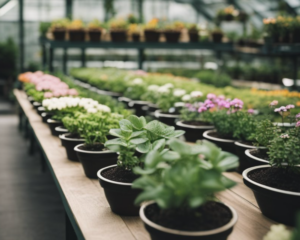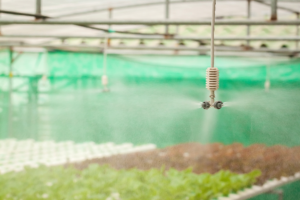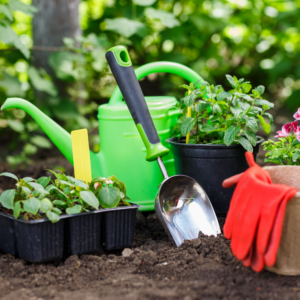Polycarbonate greenhouses have gained popularity among gardeners and commercial farmers alike due to their durability and excellent light transmission qualities. They are constructed from polycarbonate panels, which are a type of thermoplastic that’s both lighter and more resistant to breakage than traditional glass. This material has the ability to withstand extreme weather conditions, from heavy snow to high winds, making it an ideal choice for year-round plant cultivation.
The advantages of polycarbonate over other greenhouse materials extend beyond mere durability. Polycarbonate panels offer better insulation than glass, which can help maintain more consistent temperatures within the greenhouse. This feature is vital for those looking to extend the growing season or to regulate the climate for temperature-sensitive plants. Furthermore, these panels are typically treated with UV filters to protect plants from harmful ultraviolet rays while ensuring that they receive plenty of sunlight.
Ease of installation is another benefit of polycarbonate greenhouses. Lightweight panels mean that the construction process is generally quicker and may not require heavy machinery or specialized tools. For hobbyists and do-it-yourself enthusiasts, this translates to a less intimidating setup process. Additionally, with various designs and sizes available, polycarbonate greenhouses can be adapted to fit a range of needs and spaces, accommodating both small-scale gardeners and large agricultural operations.
What Is a Polycarbonate Greenhouse?
A polycarbonate greenhouse stands out for its durability and versatile glazing options. These structures utilize polycarbonate sheets for light transmission and insulation, enhancing the growing environment for a variety of plants.
Advantages of Polycarbonate Greenhouses
Polycarbonate greenhouses provide several benefits:
- Durability: They are resistant to impact, less prone to breakage than glass, and can withstand extreme weather conditions.
- Light diffusion: The sheets diffuse light, reducing the risk of plant burn and ensuring even light distribution for plant growth.
- Insulation: Polycarbonate has better insulation properties compared to glass, aiding in temperature regulation and energy efficiency.
- Maintenance: These greenhouses require minimal upkeep, thanks to their resistance to UV rays and discoloration.
Types of Polycarbonate Sheets
There are mainly two types of polycarbonate sheets used in greenhouses:
- Multi-wall Polycarbonate: It provides superior insulation with its layered structure, enhancing thermal performance and is ideal for climates with significant temperature variations.
- Corrugated Polycarbonate: This type is known for its lightweight properties and ease of installation, often used for simpler or DIY greenhouse projects.
Both types allow for modifications in design for appropriate ventilation, which is crucial for air circulation and temperature control within the greenhouse.
Choosing the Right Polycarbonate Greenhouse
When selecting a polycarbonate greenhouse, buyers should focus on quality, size, and the features that suit their gardening needs. Understanding the types of greenhouse kits available and their costs will streamline the decision-making process.
Considerations Before Purchase
Before investing in a polycarbonate greenhouse, individuals must evaluate several factors:
- Size: One should measure the intended installation area to ensure adequate space, keeping in mind the types of plants and the growth room they will need.
- Location: The site should receive sufficient sunlight and be sheltered from strong winds.
- Durability: It’s essential to look for UV-resistant polycarbonate panels to ensure longevity.
- Ventilation: Proper air circulation is crucial; thus, checking for built-in vents or the ability to add them is important.
- Framework Material: Greenhouses with aluminum or galvanized steel frames offer greater stability and lifespan.
Polycarbonate Greenhouse Kits
Polycarbonate greenhouse kits provide an accessible entry point for gardening enthusiasts:
- Price: The cost can vary widely based on size and features. Kits typically start at a few hundred dollars and can go up to several thousand.
Size Price Range Small $200 – $600 Medium $600 – $1,500 Large $1,500 – $5,000+ - Inclusions: Most kits come with all the necessary components, including the polycarbonate panels, frame, and hardware for assembly.
Purchasers should pay attention to the thickness of the polycarbonate panels, as a thicker gauge indicates better insulation and robustness. Kits may also offer add-ons such as automatic vent openers, shelving, and anchoring systems, influencing the final price.
Installation and Setup
Proper installation of a polycarbonate greenhouse is crucial for both longevity and effectiveness. The following advice focuses on the practical steps of assembling a kit and offers tips for those opting for a do-it-yourself approach.
Assembling a Greenhouse Kit
- Read the Manual: Before beginning the assembly, it’s vital they peruse the greenhouse kit’s manual thoroughly. Each kit can come with its nuances that need careful attention.
- Check the Components: They should ensure all parts listed in the kit’s inventory are present before starting.
- Foundation: They start by preparing a level base which may include a concrete foundation, pavers, or treated wood.
- Framework Assembly: They proceed with erecting the aluminum or steel frame, which usually interlocks with bolts or snap-together joints.
- Polycarbonate Panel Installation:
- Panels should slide or fit into the frame grooves.
- Sealants or clips provided in the kit are used to secure the panels in place.
- They must not over-tighten, as this could cause cracks.
- Doors and Ventilation: They attach doors and any included vent windows, often completing the kit.
DIY Tips for Polycarbonate Greenhouses
- Selection of Polycarbonate Sheets: They choose twin-wall polycarbonate sheets, renowned for their insulation properties and light diffusion.
- Cutting to Size: They must cut panels to size with a fine-toothed saw or a specialty blade designed for polycarbonate, taking care to prevent chipping.
- UV Protective Layer: They pay attention to the side of the panel with UV protection, which should be facing outward.
- Securing the Panels: They use H-profiles or aluminum tapes to seal the edges and special screws with neoprene washers to secure panels to the frame without causing damage.
- Sealing for Insulation: They ensure proper sealing around the panels with silicone caulk to improve insulation.
By taking these specific steps, they set up a sturdy and efficient polycarbonate greenhouse that can foster plant growth year-round.
Maintenance and Care
Proper maintenance and care are crucial to extend the lifespan of a polycarbonate greenhouse. Timely cleaning, repairs, and upgrades keep it functioning efficiently.
Cleaning and Repairs
Cleaning is essential to maintain the transparency and light diffusion properties of polycarbonate panels. Here are some guidelines:
- Materials: Use lukewarm soapy water and a soft cloth or sponge.
- Frequency: Clean the panels twice a year, more if in a dirty environment.
- Do Not Use: Abrasive cleaners or solvents; they can damage the panels.
For repairs:
- Scratches or Small Cracks: Apply polycarbonate repair kits.
- Seals: Check and replace weather stripping annually to maintain insulation.
| Task | Description | Frequency |
|---|---|---|
| Panel Check | Inspect for damages like yellowing or brittleness. | Biannually |
| Framework | Look for rust if metal, rot if wood, and tighten fasteners. | Annually |
| Ventilation | Clean vents and ensure they operate smoothly. | Every Season |
Upgrading Your Greenhouse
Upgrades can improve a greenhouse’s performance and sustainability:
- Ventilation: Install automatic vent openers for temperature control.
- Insulation: Use bubble wrap on paneling during colder months for insulation.
- Shading: Consider external shade cloths in summer to prevent overheating.
When upgrading:
- Compatibility: Ensure new components are compatible with existing structures.
- Warranty: Check if upgrades affect the terms of use or warranty of the greenhouse.
Remember, adherence to the terms of use for materials and components is important to not void warranties or cause unexpected problems.
Where to Buy Polycarbonate Greenhouses
Polycarbonate greenhouses are available at a variety of retailers, both in physical stores and online. Two popular options are:
- Home Depot: They offer a diverse selection of polycarbonate greenhouses. Customers can easily check inventory levels and prices online before making a purchase. Home Depot provides both in-store and online shopping experiences, with the benefit of customer reviews to guide your choice.
- Local Garden Centers: Many local stores specialize in gardening supplies. They might have competitive prices and the advantage of knowledgeable staff. However, inventory levels can vary, and it’s advisable to call ahead to confirm availability.
Online Retailers
Online shopping platforms are also useful:
- Specialized gardening websites
- General e-commerce platforms like Amazon or Walmart
Price Comparison: To ensure a smart purchase, they should compare prices across websites. Keep an eye out for sales or discounts, especially during the off-season.
Shipping and Assembly: Online purchases often come with shipping options, though buyers should be aware that greenhouses can be bulky and may require assembly upon arrival.
Checking Inventory & Prices
Here are a few tips:
- Visit retailer websites to check current prices and stock.
- Sign up for price alerts on specific models.
- For physical stores, use the “Check Store Inventory” feature online, or call the store directly.
Remember, prices can fluctuate based on sales, seasonality, and location. Always verify the most current information before making a decision.
Frequently Asked Questions (FAQs)
The following are answers to some common inquiries regarding polycarbonate greenhouses, from assembly to maintenance.
How do you assemble a polycarbonate greenhouse kit?
To assemble a kit, one starts by laying a solid foundation. They then follow the manufacturer’s instructions to construct the frame and affix the polycarbonate panels securely. Typically, the process requires basic tools and some degree of DIY skill.
Can polycarbonate greenhouse panels be cut to size?
Yes, polycarbonate panels can be trimmed to fit specific dimensions. Gardeners should use a fine-toothed saw to reduce the risk of cracking and ensure a clean cut.
What are the benefits of having a polycarbonate greenhouse over glass?
Polycarbonate greenhouses offer several advantages such as being more durable, less prone to breakage, better insulation properties, and protection from ultraviolet light compared to their glass counterparts.
How can I improve the insulation of my polycarbonate greenhouse for winter?
One can enhance insulation by applying weather stripping, using bubble wrap on the interior of panels, or installing a dual-wall polycarbonate. Sealing gaps and adding a heater can also be helpful in maintaining warmth.
What maintenance is required for a polycarbonate greenhouse?
Maintenance generally involves regular cleaning of panels to remove dirt and debris, checking for and repairing any damage to the frame or panels, and ensuring that vents and gutters are clear.
Are there any tips for cleaning polycarbonate greenhouse panels?
For cleaning panels, it is recommended to use a mild soap solution and a soft cloth or sponge to avoid scratching. Rinse with clean water and be gentle to preserve the protective coatings on the panels.

